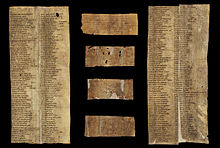Easter game by Muri
The Muri Easter game is an incomplete Easter game that has only survived in a few fragments. It was discovered in 1840 as a reinforcement for the leather-covered wooden cover of a two-volume Vulgate edition in the Muri monastery .
background
In 1840 Theodor Oehler discovered the fragments of the Easter play in the cover of a two-volume Vulgate edition in the monastery library in Muri. The parchment, which was originally a long roll with two columns and double-sided writing (see the facsimile on e-codices), was cut into strips and used as reinforcement for the cover. The Vulgate edition, a cradle print from the spring of 1466, was printed by Heinrich Eggestein in Strasbourg .
The two volumes must have belonged to a Jacob Gelinger, a clergyman who left numerous marginal notes in the Vulgate Bible and a proof of ownership on the last page of Volume 2. There you can read " 1527 Dominus Jacobus Gelinger alias Erni ". The Vulgate Bible was probably bound before 1527, when the Easter game fragments were also used. After this point in time, the volumes came into the possession of the Muri monastery, as evidenced by a corresponding proof of ownership " Monasterii Murensis " from the 16th century. After the abolition of the monastery in 1841, the extensive libraries from the Wettingen and Muri monasteries - and thus both the two-volume Bible and the Easter game - came to the Aargau cantonal library .
The Muri Easter play was probably made in the middle of the 13th century (1240–50). Language analyzes suggest an origin from the central or western part of the High Alemannic region (Zurich?). The recording of the Easter play only included the German verses, no details of the director or the sung Latin pieces are recorded. As Rolf Bergmann has shown, this does not mean that it was a pure speech drama without Latin or musical elements, but only that the parchment roll did not record this information. Possibly it was intended for the director or prompter of the text.
The fact that the above-mentioned Jakob Gelinger (or Geilinger, a thriving Zurich family) is documented as a chaplain at the Grossmünster Zurich in 1504 speaks for the origin of the Easter play in the then imperial city of Zurich. The leather strap of the two-volume Bible, whose wooden lid has been padded with the scraps of the Easter game, comes from around 1500 and also from Zurich. Jakob Geilinger last served as mass priest in Albisrieden in 1525 , refused the Reformation and emigrated, perhaps to the Muri monastery. The text of the Easter game has nothing to do with Muri. The monks there in the 13th century had neither the audience nor the actors they needed: shopkeepers, three Marys, knights, servants, Pilate, the Jews, the guards, the devils in Hell. It is a religious play by bourgeois actors in front of a large urban audience. The Münsterhof, the largest city square in Zurich, comes into question as a performance location.
Edition
For the edition, the parchment strips with the text of the Easter game were removed from the wooden lids. The fact that traces of writing were left on the wood later made the work of the editors easier, who could no longer decipher some passages on the parchment alone. The first edition was made in 1846 by Karl Oehler , the brother of the discoverer in Aarau . In 1863 Karl Bartsch and in 1937 Eduard Hartl published the Easter game, with various errors in the edition being corrected. Friedrich Ranke , German studies at Basel University , finally got the first independent and academic edition of the Easter game in 1944.
expenditure
- The Muri Easter game. Facsimile printing of the fragments and reconstruction of the parchment scroll. Text of the Easter game based on the edition by Friedrich Ranke. Translation by Max Wehrli . Edited under the patronage of the government council of the Canton of Aargau. Basel 1967.
- The Easter game by Muri facsimile on e-codices, Switzerland's virtual manuscript library. Easter game by Muri
- The Muri Easter Game Text edition with an English introduction by Nigel F. Palmer , updated February 2015 by Henrike Lähnemann on the Weblearn server of Oxford University, Muri Easter Game
literature
- Max Wehrli: Muri Easter play. In: 2 VL 7 (1989), spp. 119-124 Google Booksearch
- Jean-Pierre Bodmer & Martin Germann: Kantonsbibliothek Zürich ... Exhibition 1985/1986, Zentralbibliothek Zürich 1985, p. 34, catalog number 21.
- Theater Lexikon der Schweiz / ed. Andreas Kotte. - Zurich, Chronos-Verlag, 2005, 3 volumes, see also online: http://tls.theaterwissenschaft.ch/wiki/Osterspiele
Remarks
- ↑ See also in the complete catalog of the Wiegendrucke, Vol. IV, Leipzig 1930, No. 4205
- ↑ Max Wehrli: Osterspiel von Muri, in: 2VL 7 (1989), Sp. 119–124
- ↑ Rolf Bergmann, 'Tradition, interpretation and literaturgeschichtliche position des Osterspiel von Muri', in: International Archive for Social History of German Literature 9 (1984), pp. 1–21.

